Vinatex Da Nang JSC: Analysis of Company Types and Structures
VerifiedAdded on 2021/11/24
|30
|7344
|101
Report
AI Summary
This report, prepared by an assistant business analyst at Vinatex Da Nang Joint Stock Company, provides a detailed examination of different company types and organizational structures. The report begins with an introduction to the Vietnamese business environment, highlighting the importance of understanding various organizational forms before establishing a firm. It defines and differentiates between public, private, and volunteer sectors, and then delves into specific legal forms such as sole traders, partnerships, private limited companies, and public limited enterprises. Further, it categorizes businesses by size (micro, small, medium, and big) and industry sector (primary, secondary, and tertiary). The report also analyzes business scope (international, local, and national) and purpose (profit and nonprofit). A significant portion of the report is dedicated to a case study of Vietjet Air, including its history, ownership, key players, business activities, legal form, and organizational structure, with a focus on its functional structure. The report concludes with an overview of Vietjet Air's stakeholders and provides insights into the company's operations and strategic positioning in the aviation industry.

REDO
Introduction
In today's society, commercial operations in the Vietnamese market, as well as the rest of the
globe, are highly interesting. According to the General Statistics Office, Vietnam set a new
record in 2018 by establishing 131.1 thousand enterprises. Furthermore, over 12.5 thousand
enterprises in Vietnam fail each year. As a result, understanding the business environment and
the structure of many different types of organizations is recommended before establishing a firm.
The influencing elements that are directly connected to company operations are referred to as the
business environment. These elements have an impact on the company's outcomes, performance,
and growth, both within and outside. As a result, BE is the key to enormous success.
As an assistant business analyst at Vinatex Da Nang Joint Stock Company, I'm in charge of
producing a report to the CEO regarding researching and describing three distinct sorts of
companies: Vinatex DaNang JSC, Vinamilk JSC, and Vietjet Air.
This article will provide an overview of each of the three companies mentioned above, as well as
clear information and explanations. It will also evaluate the various business functions for
Vinatex Da Nang JSC, as well as the benefits and drawbacks of how they relate to and impact
the company's structure. The conclusion and reference list are included in the final section.
Types and Purposes of Organizations
The Public sector refers to the portion of the economy that is impacted by the government to
some extent. This group includes the military, civil service, police, and other civil servants, as
well as any publicly controlled economic businesses. While the public sector varies every
country owing to the regulations that govern public institutions, the public sector in general is
more focused with providing services that benefit society as a whole. It is only available to those
that utilize the service (Wegrich, 2014).
Volunteer sector: The phrase voluntary sector refers to non-profit organizations whose main
purpose is not to benefit but to provide a beneficial societal influence. It is also known as the
non-profit, civilized or third-sector sector. Despite the distinction between the voluntary sector
and the government, various organizations work with governments at every level to support them
Introduction
In today's society, commercial operations in the Vietnamese market, as well as the rest of the
globe, are highly interesting. According to the General Statistics Office, Vietnam set a new
record in 2018 by establishing 131.1 thousand enterprises. Furthermore, over 12.5 thousand
enterprises in Vietnam fail each year. As a result, understanding the business environment and
the structure of many different types of organizations is recommended before establishing a firm.
The influencing elements that are directly connected to company operations are referred to as the
business environment. These elements have an impact on the company's outcomes, performance,
and growth, both within and outside. As a result, BE is the key to enormous success.
As an assistant business analyst at Vinatex Da Nang Joint Stock Company, I'm in charge of
producing a report to the CEO regarding researching and describing three distinct sorts of
companies: Vinatex DaNang JSC, Vinamilk JSC, and Vietjet Air.
This article will provide an overview of each of the three companies mentioned above, as well as
clear information and explanations. It will also evaluate the various business functions for
Vinatex Da Nang JSC, as well as the benefits and drawbacks of how they relate to and impact
the company's structure. The conclusion and reference list are included in the final section.
Types and Purposes of Organizations
The Public sector refers to the portion of the economy that is impacted by the government to
some extent. This group includes the military, civil service, police, and other civil servants, as
well as any publicly controlled economic businesses. While the public sector varies every
country owing to the regulations that govern public institutions, the public sector in general is
more focused with providing services that benefit society as a whole. It is only available to those
that utilize the service (Wegrich, 2014).
Volunteer sector: The phrase voluntary sector refers to non-profit organizations whose main
purpose is not to benefit but to provide a beneficial societal influence. It is also known as the
non-profit, civilized or third-sector sector. Despite the distinction between the voluntary sector
and the government, various organizations work with governments at every level to support them
Paraphrase This Document
Need a fresh take? Get an instant paraphrase of this document with our AI Paraphraser
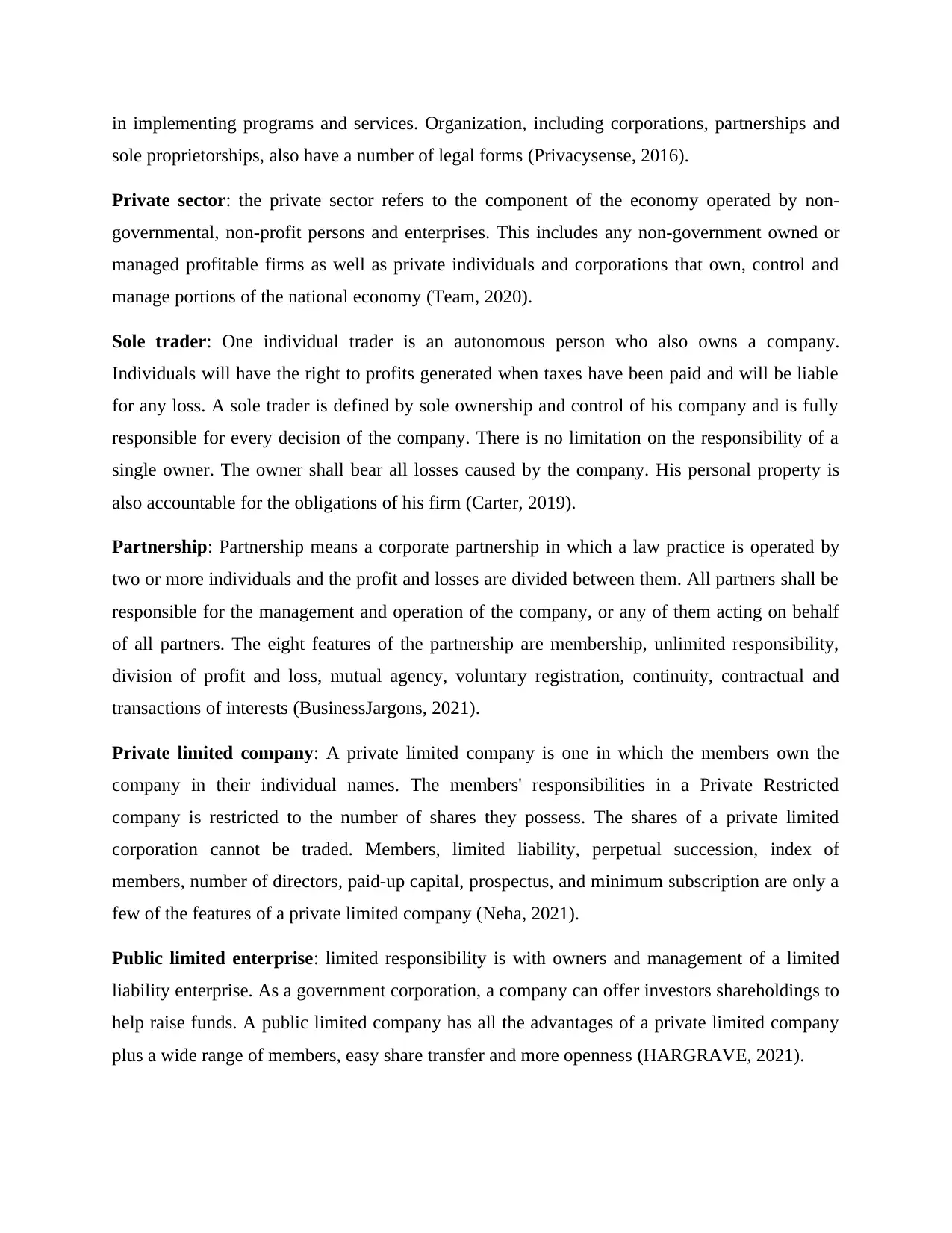
in implementing programs and services. Organization, including corporations, partnerships and
sole proprietorships, also have a number of legal forms (Privacysense, 2016).
Private sector: the private sector refers to the component of the economy operated by non-
governmental, non-profit persons and enterprises. This includes any non-government owned or
managed profitable firms as well as private individuals and corporations that own, control and
manage portions of the national economy (Team, 2020).
Sole trader: One individual trader is an autonomous person who also owns a company.
Individuals will have the right to profits generated when taxes have been paid and will be liable
for any loss. A sole trader is defined by sole ownership and control of his company and is fully
responsible for every decision of the company. There is no limitation on the responsibility of a
single owner. The owner shall bear all losses caused by the company. His personal property is
also accountable for the obligations of his firm (Carter, 2019).
Partnership: Partnership means a corporate partnership in which a law practice is operated by
two or more individuals and the profit and losses are divided between them. All partners shall be
responsible for the management and operation of the company, or any of them acting on behalf
of all partners. The eight features of the partnership are membership, unlimited responsibility,
division of profit and loss, mutual agency, voluntary registration, continuity, contractual and
transactions of interests (BusinessJargons, 2021).
Private limited company: A private limited company is one in which the members own the
company in their individual names. The members' responsibilities in a Private Restricted
company is restricted to the number of shares they possess. The shares of a private limited
corporation cannot be traded. Members, limited liability, perpetual succession, index of
members, number of directors, paid-up capital, prospectus, and minimum subscription are only a
few of the features of a private limited company (Neha, 2021).
Public limited enterprise: limited responsibility is with owners and management of a limited
liability enterprise. As a government corporation, a company can offer investors shareholdings to
help raise funds. A public limited company has all the advantages of a private limited company
plus a wide range of members, easy share transfer and more openness (HARGRAVE, 2021).
sole proprietorships, also have a number of legal forms (Privacysense, 2016).
Private sector: the private sector refers to the component of the economy operated by non-
governmental, non-profit persons and enterprises. This includes any non-government owned or
managed profitable firms as well as private individuals and corporations that own, control and
manage portions of the national economy (Team, 2020).
Sole trader: One individual trader is an autonomous person who also owns a company.
Individuals will have the right to profits generated when taxes have been paid and will be liable
for any loss. A sole trader is defined by sole ownership and control of his company and is fully
responsible for every decision of the company. There is no limitation on the responsibility of a
single owner. The owner shall bear all losses caused by the company. His personal property is
also accountable for the obligations of his firm (Carter, 2019).
Partnership: Partnership means a corporate partnership in which a law practice is operated by
two or more individuals and the profit and losses are divided between them. All partners shall be
responsible for the management and operation of the company, or any of them acting on behalf
of all partners. The eight features of the partnership are membership, unlimited responsibility,
division of profit and loss, mutual agency, voluntary registration, continuity, contractual and
transactions of interests (BusinessJargons, 2021).
Private limited company: A private limited company is one in which the members own the
company in their individual names. The members' responsibilities in a Private Restricted
company is restricted to the number of shares they possess. The shares of a private limited
corporation cannot be traded. Members, limited liability, perpetual succession, index of
members, number of directors, paid-up capital, prospectus, and minimum subscription are only a
few of the features of a private limited company (Neha, 2021).
Public limited enterprise: limited responsibility is with owners and management of a limited
liability enterprise. As a government corporation, a company can offer investors shareholdings to
help raise funds. A public limited company has all the advantages of a private limited company
plus a wide range of members, easy share transfer and more openness (HARGRAVE, 2021).

Micro business: a company with less than 10 employees and yearly turnover of less than $25
000 in annual sales (money taken during a given amount of time) (Murray, 2020).
Small business: Small firms are private companies that need less money, fewer staff and little or
no machinery. All of them are exemplary small companies, including grocery, medical, retail,
bakeries and small industrial units.
Medium Business: a medium-sized business employs fewer than 250 people and has less than
€50 million in yearly revenue or below €43 million in budgets. SMEs that meet different needs
can benefit (Enterpriseireland, 2007).
A Big Company, which has an annual sales of minimum EUR 1.5 billion and a total balance of
at least Euro 2 billion, meets at least one of two criteria: the employer employs 5,000 people
(Sangoma, 2019).
Industries Sector
Primary Industry: agriculture, forestry, animal and fisheries are genetic industries which, in the
area of the National Economics, are sensitive to scientific and technical advancements in
renewable resources. All mining companies are instances of mining ores, quarries and mineral
fuel extraction. Primary industries dominate the undeveloped and developing economies
(Britannica, 2020).
Secondary industry: this business, commonly referred to as manufacturing, uses primary
industry raw resources and converts them into consumer products or processes that are already
supplied by secondary industry. Convert into products or build means of production to make
consumer and non-consumable goods. Energy companies also fall under the classification of
secondary industries (Britannica, 2020).
Tertiary industry: This industry, often known as the service industry, includes companies that
provide services, acquire intangible assets, or generate revenue without producing physical
goods. The private and governmental sectors are commonly integrated in free market and mixed
economies (Britannica, 2020).
Business scope
000 in annual sales (money taken during a given amount of time) (Murray, 2020).
Small business: Small firms are private companies that need less money, fewer staff and little or
no machinery. All of them are exemplary small companies, including grocery, medical, retail,
bakeries and small industrial units.
Medium Business: a medium-sized business employs fewer than 250 people and has less than
€50 million in yearly revenue or below €43 million in budgets. SMEs that meet different needs
can benefit (Enterpriseireland, 2007).
A Big Company, which has an annual sales of minimum EUR 1.5 billion and a total balance of
at least Euro 2 billion, meets at least one of two criteria: the employer employs 5,000 people
(Sangoma, 2019).
Industries Sector
Primary Industry: agriculture, forestry, animal and fisheries are genetic industries which, in the
area of the National Economics, are sensitive to scientific and technical advancements in
renewable resources. All mining companies are instances of mining ores, quarries and mineral
fuel extraction. Primary industries dominate the undeveloped and developing economies
(Britannica, 2020).
Secondary industry: this business, commonly referred to as manufacturing, uses primary
industry raw resources and converts them into consumer products or processes that are already
supplied by secondary industry. Convert into products or build means of production to make
consumer and non-consumable goods. Energy companies also fall under the classification of
secondary industries (Britannica, 2020).
Tertiary industry: This industry, often known as the service industry, includes companies that
provide services, acquire intangible assets, or generate revenue without producing physical
goods. The private and governmental sectors are commonly integrated in free market and mixed
economies (Britannica, 2020).
Business scope
⊘ This is a preview!⊘
Do you want full access?
Subscribe today to unlock all pages.

Trusted by 1+ million students worldwide

• International business: Activities that take place outside of a country's borders are referred to as
international business. Money, labor, technology, and intellectual property such as patents,
trademarks, know-how, and copyrights, as well as international trade in products and services,
are all covered.
• Local business: A local business sells its products and services to individuals who live in the
same city, town, or area. A local business benefits by knowing the interests, needs, and culture of
its community, as well as offering goods and services that its inhabitants will buy.
• National business: A national business is one that operates solely inside the borders of a
country. A national company, like a local company, is cognizant of the country's culture and
develops goods and services to satisfy the demands of its target market.
Purpose
• Profit: Profit is the financial benefit received when the revenue generated by a commercial
activity exceeds the costs, expenses, and taxes connected with operating the business. Any
profits earned will be returned to the business owners, who will have the option of keeping or
reinvesting the funds. To arrive at profit, entire income is deducted from total costs (Kenton,
2020).
• Nonprofit: A nonprofit organization is one in which no profit is made by the owners. All
monies earned or donated to a nonprofit organization are used to help the organization achieve
its goals and stay afloat. Nonprofits are typically tax-exempt charities or other types of public
service organizations, which means they are exempt from paying most taxes (Kenton, 2020).
Legal Status
Refers to a recognized individual's, legal entity's, organization's, or corporation's legal identity in
relation to themselves and other parties, allowing them to carry out their obligations and actions
with full legal liability (Eustat, 2019).
international business. Money, labor, technology, and intellectual property such as patents,
trademarks, know-how, and copyrights, as well as international trade in products and services,
are all covered.
• Local business: A local business sells its products and services to individuals who live in the
same city, town, or area. A local business benefits by knowing the interests, needs, and culture of
its community, as well as offering goods and services that its inhabitants will buy.
• National business: A national business is one that operates solely inside the borders of a
country. A national company, like a local company, is cognizant of the country's culture and
develops goods and services to satisfy the demands of its target market.
Purpose
• Profit: Profit is the financial benefit received when the revenue generated by a commercial
activity exceeds the costs, expenses, and taxes connected with operating the business. Any
profits earned will be returned to the business owners, who will have the option of keeping or
reinvesting the funds. To arrive at profit, entire income is deducted from total costs (Kenton,
2020).
• Nonprofit: A nonprofit organization is one in which no profit is made by the owners. All
monies earned or donated to a nonprofit organization are used to help the organization achieve
its goals and stay afloat. Nonprofits are typically tax-exempt charities or other types of public
service organizations, which means they are exempt from paying most taxes (Kenton, 2020).
Legal Status
Refers to a recognized individual's, legal entity's, organization's, or corporation's legal identity in
relation to themselves and other parties, allowing them to carry out their obligations and actions
with full legal liability (Eustat, 2019).
Paraphrase This Document
Need a fresh take? Get an instant paraphrase of this document with our AI Paraphraser
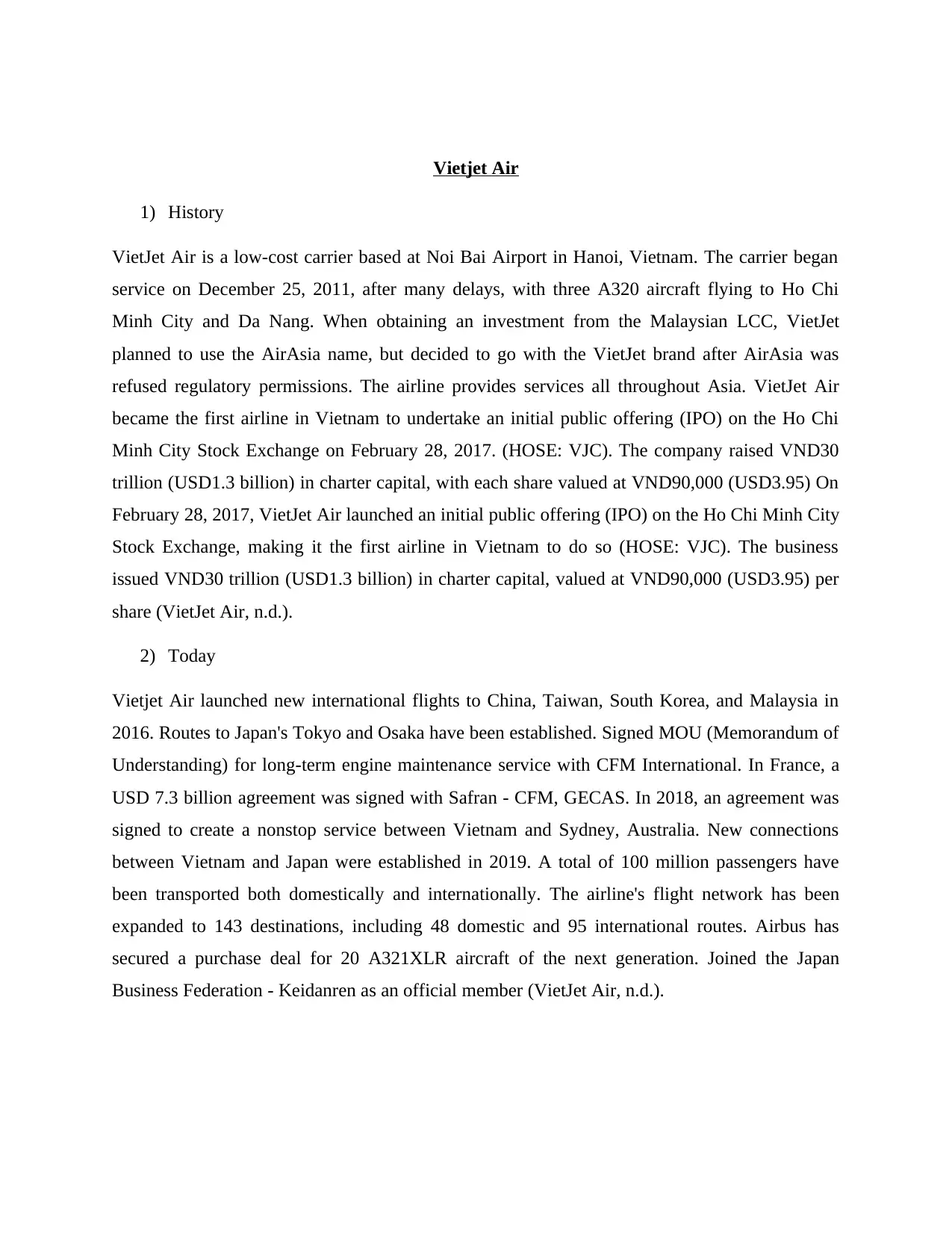
Vietjet Air
1) History
VietJet Air is a low-cost carrier based at Noi Bai Airport in Hanoi, Vietnam. The carrier began
service on December 25, 2011, after many delays, with three A320 aircraft flying to Ho Chi
Minh City and Da Nang. When obtaining an investment from the Malaysian LCC, VietJet
planned to use the AirAsia name, but decided to go with the VietJet brand after AirAsia was
refused regulatory permissions. The airline provides services all throughout Asia. VietJet Air
became the first airline in Vietnam to undertake an initial public offering (IPO) on the Ho Chi
Minh City Stock Exchange on February 28, 2017. (HOSE: VJC). The company raised VND30
trillion (USD1.3 billion) in charter capital, with each share valued at VND90,000 (USD3.95) On
February 28, 2017, VietJet Air launched an initial public offering (IPO) on the Ho Chi Minh City
Stock Exchange, making it the first airline in Vietnam to do so (HOSE: VJC). The business
issued VND30 trillion (USD1.3 billion) in charter capital, valued at VND90,000 (USD3.95) per
share (VietJet Air, n.d.).
2) Today
Vietjet Air launched new international flights to China, Taiwan, South Korea, and Malaysia in
2016. Routes to Japan's Tokyo and Osaka have been established. Signed MOU (Memorandum of
Understanding) for long-term engine maintenance service with CFM International. In France, a
USD 7.3 billion agreement was signed with Safran - CFM, GECAS. In 2018, an agreement was
signed to create a nonstop service between Vietnam and Sydney, Australia. New connections
between Vietnam and Japan were established in 2019. A total of 100 million passengers have
been transported both domestically and internationally. The airline's flight network has been
expanded to 143 destinations, including 48 domestic and 95 international routes. Airbus has
secured a purchase deal for 20 A321XLR aircraft of the next generation. Joined the Japan
Business Federation - Keidanren as an official member (VietJet Air, n.d.).
1) History
VietJet Air is a low-cost carrier based at Noi Bai Airport in Hanoi, Vietnam. The carrier began
service on December 25, 2011, after many delays, with three A320 aircraft flying to Ho Chi
Minh City and Da Nang. When obtaining an investment from the Malaysian LCC, VietJet
planned to use the AirAsia name, but decided to go with the VietJet brand after AirAsia was
refused regulatory permissions. The airline provides services all throughout Asia. VietJet Air
became the first airline in Vietnam to undertake an initial public offering (IPO) on the Ho Chi
Minh City Stock Exchange on February 28, 2017. (HOSE: VJC). The company raised VND30
trillion (USD1.3 billion) in charter capital, with each share valued at VND90,000 (USD3.95) On
February 28, 2017, VietJet Air launched an initial public offering (IPO) on the Ho Chi Minh City
Stock Exchange, making it the first airline in Vietnam to do so (HOSE: VJC). The business
issued VND30 trillion (USD1.3 billion) in charter capital, valued at VND90,000 (USD3.95) per
share (VietJet Air, n.d.).
2) Today
Vietjet Air launched new international flights to China, Taiwan, South Korea, and Malaysia in
2016. Routes to Japan's Tokyo and Osaka have been established. Signed MOU (Memorandum of
Understanding) for long-term engine maintenance service with CFM International. In France, a
USD 7.3 billion agreement was signed with Safran - CFM, GECAS. In 2018, an agreement was
signed to create a nonstop service between Vietnam and Sydney, Australia. New connections
between Vietnam and Japan were established in 2019. A total of 100 million passengers have
been transported both domestically and internationally. The airline's flight network has been
expanded to 143 destinations, including 48 domestic and 95 international routes. Airbus has
secured a purchase deal for 20 A321XLR aircraft of the next generation. Joined the Japan
Business Federation - Keidanren as an official member (VietJet Air, n.d.).

Unit: Million Dong (Source: https://finance.vietstock.vn/VJC-ctcp-hang-khong-vietjet.htm)
3) Overview
Company Vietjet Air
Ownership (Private Sector or Public
Sector)
Private Sector
Key players ( stakeholders) Shareholders, Employees, Diretor
Profit or Not for Profit Profit
Size Large enterprise
Business Activity (s) Air transport for passengers and
freight.
Ancillary services.
Aviation training
3) Overview
Company Vietjet Air
Ownership (Private Sector or Public
Sector)
Private Sector
Key players ( stakeholders) Shareholders, Employees, Diretor
Profit or Not for Profit Profit
Size Large enterprise
Business Activity (s) Air transport for passengers and
freight.
Ancillary services.
Aviation training
⊘ This is a preview!⊘
Do you want full access?
Subscribe today to unlock all pages.

Trusted by 1+ million students worldwide
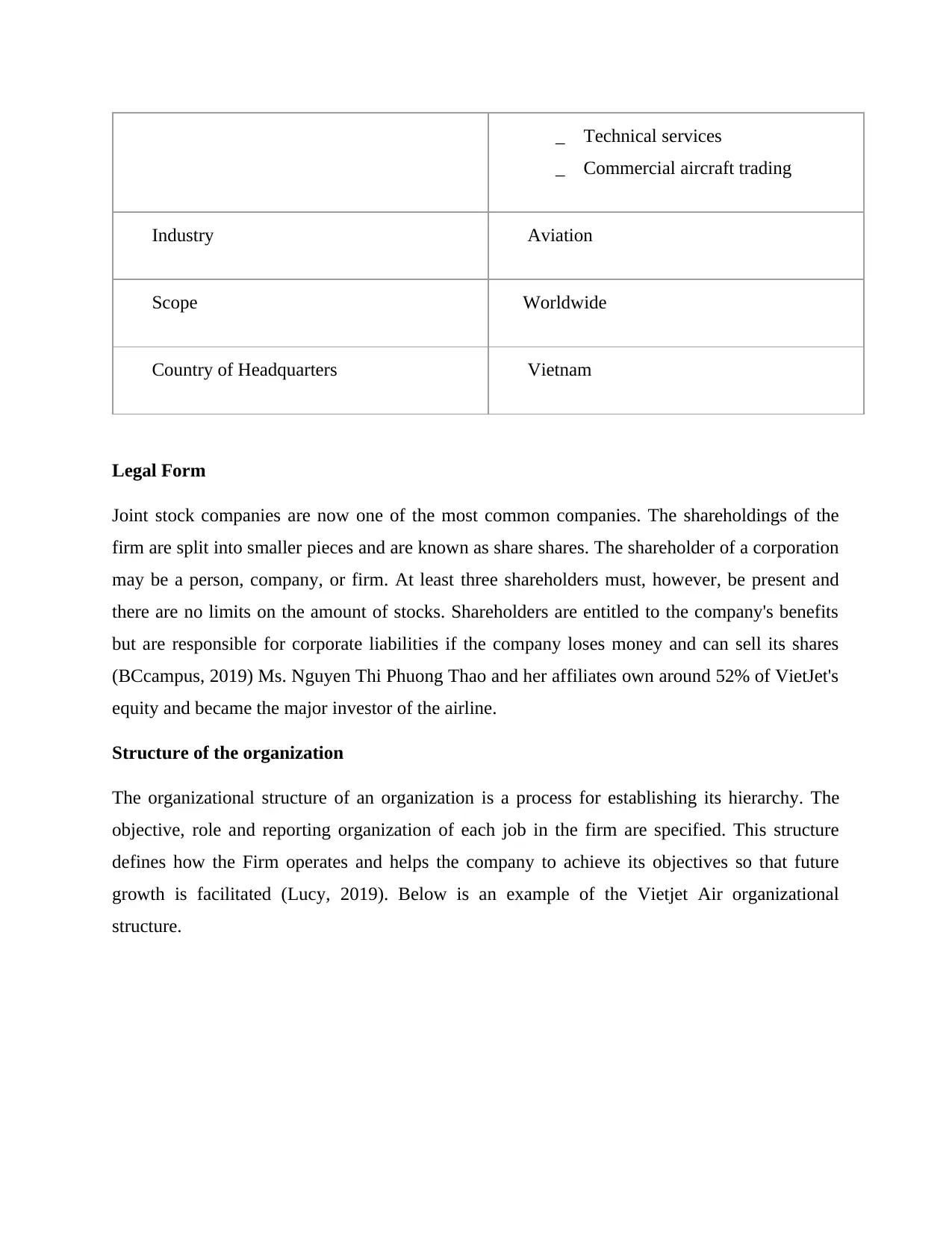
Technical services
Commercial aircraft trading
Industry Aviation
Scope Worldwide
Country of Headquarters Vietnam
Legal Form
Joint stock companies are now one of the most common companies. The shareholdings of the
firm are split into smaller pieces and are known as share shares. The shareholder of a corporation
may be a person, company, or firm. At least three shareholders must, however, be present and
there are no limits on the amount of stocks. Shareholders are entitled to the company's benefits
but are responsible for corporate liabilities if the company loses money and can sell its shares
(BCcampus, 2019) Ms. Nguyen Thi Phuong Thao and her affiliates own around 52% of VietJet's
equity and became the major investor of the airline.
Structure of the organization
The organizational structure of an organization is a process for establishing its hierarchy. The
objective, role and reporting organization of each job in the firm are specified. This structure
defines how the Firm operates and helps the company to achieve its objectives so that future
growth is facilitated (Lucy, 2019). Below is an example of the Vietjet Air organizational
structure.
Commercial aircraft trading
Industry Aviation
Scope Worldwide
Country of Headquarters Vietnam
Legal Form
Joint stock companies are now one of the most common companies. The shareholdings of the
firm are split into smaller pieces and are known as share shares. The shareholder of a corporation
may be a person, company, or firm. At least three shareholders must, however, be present and
there are no limits on the amount of stocks. Shareholders are entitled to the company's benefits
but are responsible for corporate liabilities if the company loses money and can sell its shares
(BCcampus, 2019) Ms. Nguyen Thi Phuong Thao and her affiliates own around 52% of VietJet's
equity and became the major investor of the airline.
Structure of the organization
The organizational structure of an organization is a process for establishing its hierarchy. The
objective, role and reporting organization of each job in the firm are specified. This structure
defines how the Firm operates and helps the company to achieve its objectives so that future
growth is facilitated (Lucy, 2019). Below is an example of the Vietjet Air organizational
structure.
Paraphrase This Document
Need a fresh take? Get an instant paraphrase of this document with our AI Paraphraser
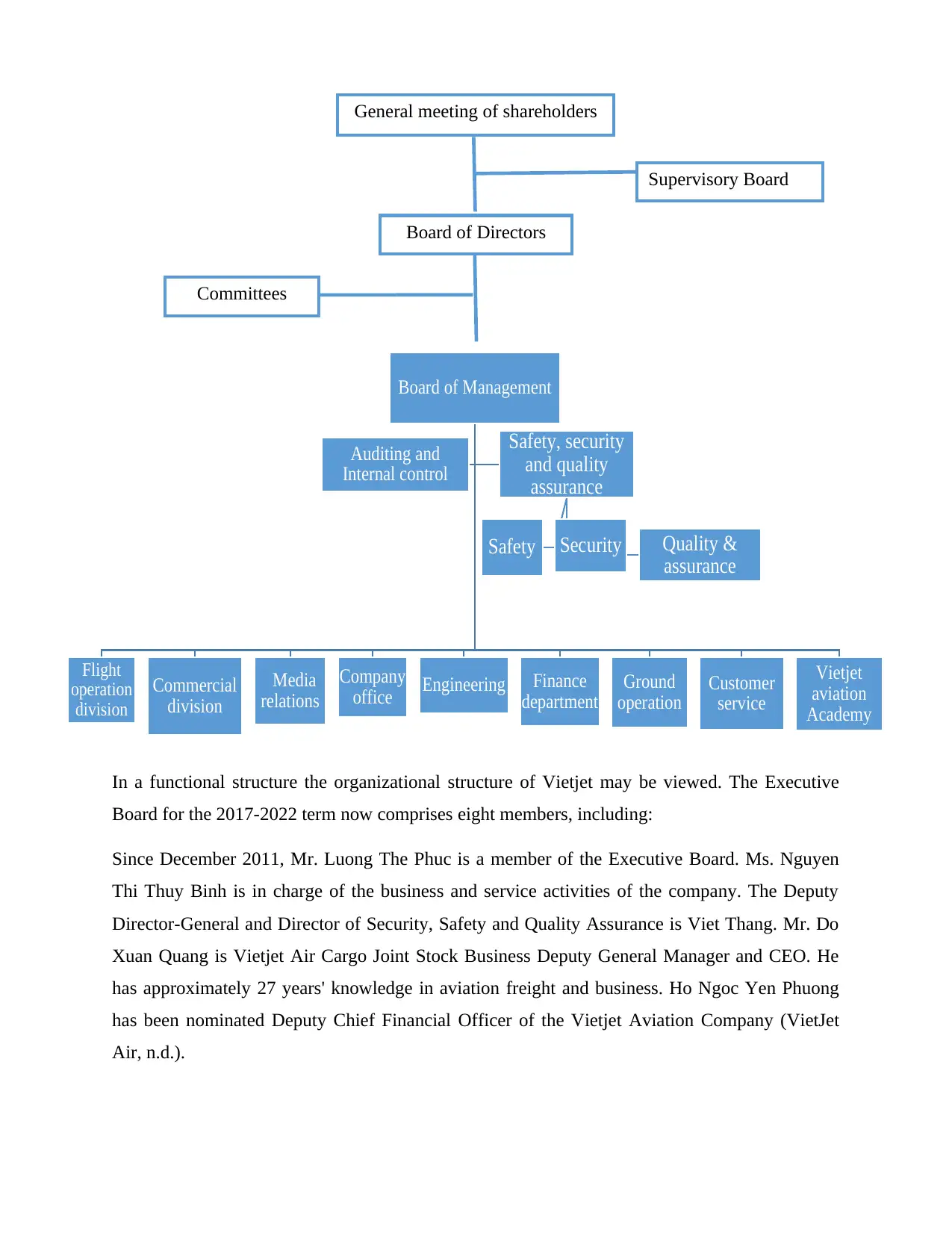
In a functional structure the organizational structure of Vietjet may be viewed. The Executive
Board for the 2017-2022 term now comprises eight members, including:
Since December 2011, Mr. Luong The Phuc is a member of the Executive Board. Ms. Nguyen
Thi Thuy Binh is in charge of the business and service activities of the company. The Deputy
Director-General and Director of Security, Safety and Quality Assurance is Viet Thang. Mr. Do
Xuan Quang is Vietjet Air Cargo Joint Stock Business Deputy General Manager and CEO. He
has approximately 27 years' knowledge in aviation freight and business. Ho Ngoc Yen Phuong
has been nominated Deputy Chief Financial Officer of the Vietjet Aviation Company (VietJet
Air, n.d.).
Board of Management
Vietjet
aviation
Academy
Customer
service
Ground
operation
Finance
department
EngineeringCompany
office
Media
relations
Commercial
division
Flight
operation
division
Safety, security
and quality
assurance
SecuritySafety Quality &
assurance
Auditing and
Internal control
General meeting of shareholders
Supervisory Board
Committees
Board of Directors
Board for the 2017-2022 term now comprises eight members, including:
Since December 2011, Mr. Luong The Phuc is a member of the Executive Board. Ms. Nguyen
Thi Thuy Binh is in charge of the business and service activities of the company. The Deputy
Director-General and Director of Security, Safety and Quality Assurance is Viet Thang. Mr. Do
Xuan Quang is Vietjet Air Cargo Joint Stock Business Deputy General Manager and CEO. He
has approximately 27 years' knowledge in aviation freight and business. Ho Ngoc Yen Phuong
has been nominated Deputy Chief Financial Officer of the Vietjet Aviation Company (VietJet
Air, n.d.).
Board of Management
Vietjet
aviation
Academy
Customer
service
Ground
operation
Finance
department
EngineeringCompany
office
Media
relations
Commercial
division
Flight
operation
division
Safety, security
and quality
assurance
SecuritySafety Quality &
assurance
Auditing and
Internal control
General meeting of shareholders
Supervisory Board
Committees
Board of Directors
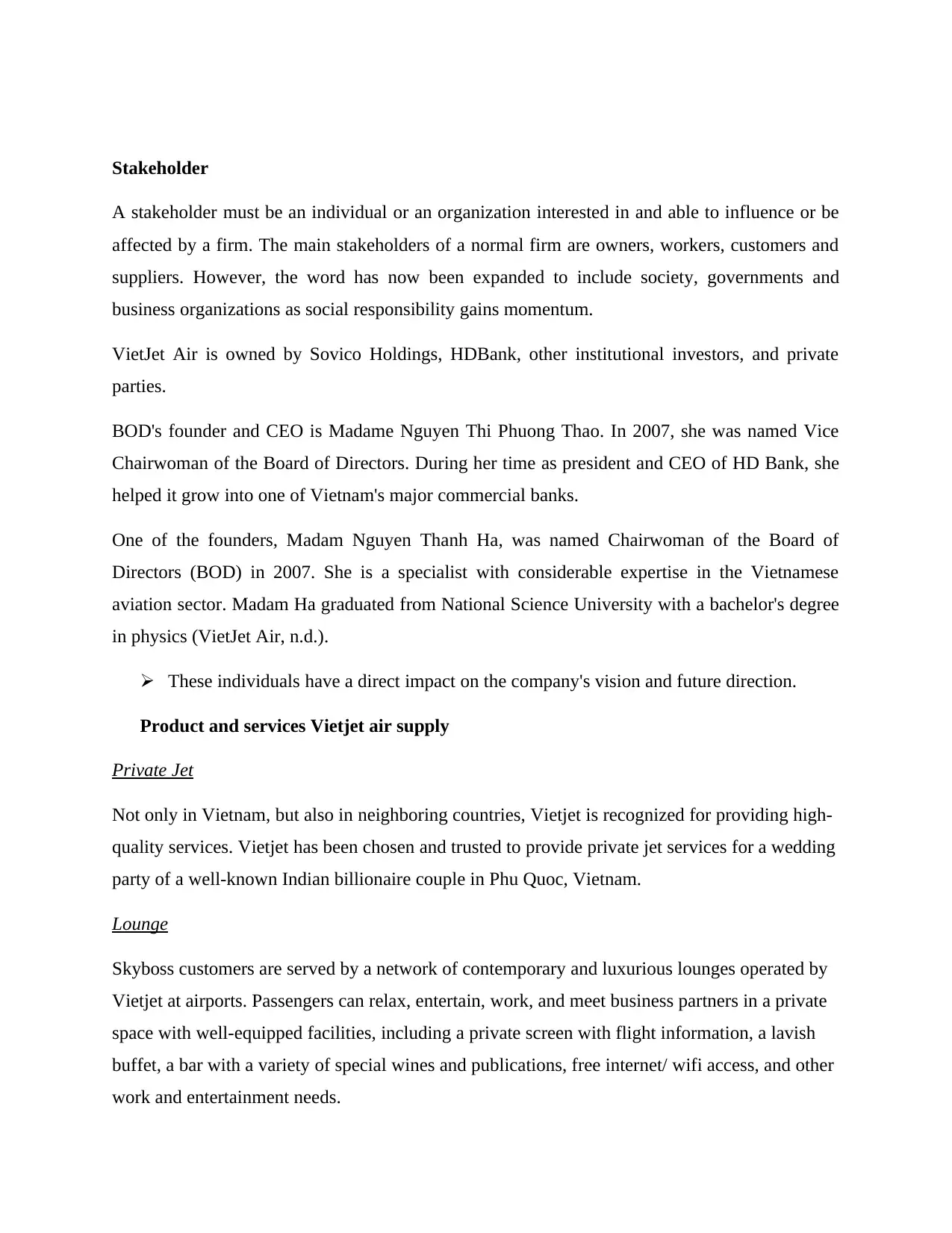
Stakeholder
A stakeholder must be an individual or an organization interested in and able to influence or be
affected by a firm. The main stakeholders of a normal firm are owners, workers, customers and
suppliers. However, the word has now been expanded to include society, governments and
business organizations as social responsibility gains momentum.
VietJet Air is owned by Sovico Holdings, HDBank, other institutional investors, and private
parties.
BOD's founder and CEO is Madame Nguyen Thi Phuong Thao. In 2007, she was named Vice
Chairwoman of the Board of Directors. During her time as president and CEO of HD Bank, she
helped it grow into one of Vietnam's major commercial banks.
One of the founders, Madam Nguyen Thanh Ha, was named Chairwoman of the Board of
Directors (BOD) in 2007. She is a specialist with considerable expertise in the Vietnamese
aviation sector. Madam Ha graduated from National Science University with a bachelor's degree
in physics (VietJet Air, n.d.).
These individuals have a direct impact on the company's vision and future direction.
Product and services Vietjet air supply
Private Jet
Not only in Vietnam, but also in neighboring countries, Vietjet is recognized for providing high-
quality services. Vietjet has been chosen and trusted to provide private jet services for a wedding
party of a well-known Indian billionaire couple in Phu Quoc, Vietnam.
Lounge
Skyboss customers are served by a network of contemporary and luxurious lounges operated by
Vietjet at airports. Passengers can relax, entertain, work, and meet business partners in a private
space with well-equipped facilities, including a private screen with flight information, a lavish
buffet, a bar with a variety of special wines and publications, free internet/ wifi access, and other
work and entertainment needs.
A stakeholder must be an individual or an organization interested in and able to influence or be
affected by a firm. The main stakeholders of a normal firm are owners, workers, customers and
suppliers. However, the word has now been expanded to include society, governments and
business organizations as social responsibility gains momentum.
VietJet Air is owned by Sovico Holdings, HDBank, other institutional investors, and private
parties.
BOD's founder and CEO is Madame Nguyen Thi Phuong Thao. In 2007, she was named Vice
Chairwoman of the Board of Directors. During her time as president and CEO of HD Bank, she
helped it grow into one of Vietnam's major commercial banks.
One of the founders, Madam Nguyen Thanh Ha, was named Chairwoman of the Board of
Directors (BOD) in 2007. She is a specialist with considerable expertise in the Vietnamese
aviation sector. Madam Ha graduated from National Science University with a bachelor's degree
in physics (VietJet Air, n.d.).
These individuals have a direct impact on the company's vision and future direction.
Product and services Vietjet air supply
Private Jet
Not only in Vietnam, but also in neighboring countries, Vietjet is recognized for providing high-
quality services. Vietjet has been chosen and trusted to provide private jet services for a wedding
party of a well-known Indian billionaire couple in Phu Quoc, Vietnam.
Lounge
Skyboss customers are served by a network of contemporary and luxurious lounges operated by
Vietjet at airports. Passengers can relax, entertain, work, and meet business partners in a private
space with well-equipped facilities, including a private screen with flight information, a lavish
buffet, a bar with a variety of special wines and publications, free internet/ wifi access, and other
work and entertainment needs.
⊘ This is a preview!⊘
Do you want full access?
Subscribe today to unlock all pages.

Trusted by 1+ million students worldwide

Flight entertainment activities
Interact with passengers on board and organize entertainment events like as Carnival Dances,
Gangnam-style dances, and airplane weddings, among others, with the involvement of well-
known singers and artists. Vietjet also sends out presents to clients on important occasions such
as Tet Holiday Lucky Money, modest gifts of free tickets for Christmas, Women's Day,
Children's Day, and so on.
Meals served in the air
In-flight meals are produced by five-star restaurant chefs and comprise nine hot entrees, quick
food, and snacks, as well as more than 20 varieties of hot and cold drinks in European and Asian
styles. In addition, Vietjet offers vegan and dietetic meals to guests who request them.
Unlimited entertainment with high-tech equipment.
The aircrafts of Vietjet are equipped with cutting-edge technology to satisfy the needs of
passengers. Inflight passengers may watch the newest movies, play interactive games, and listen
to music.
Shopping for one-of-a-kind trinkets and chatting with One 2 Fly
Offer one-of-a-kind souvenirs and travel publications. One 2 Fly is a high-end travel magazine.
SKYBOSS – Leadership Style
Many unique services are available to VIP customers on Vietjet's high-class services, including:
Priority check-in
opulent lounges;
a first-come, first-served seat;
Ticket that can be changed;
Transportation from a private vehicle to an airplane;
In-flight food and beverages are complimentary;
30kg of checked luggage is included for free, as well as a set of golf clubs bag.
Distribution and marketing
Vietjet's main distribution platforms are its
Interact with passengers on board and organize entertainment events like as Carnival Dances,
Gangnam-style dances, and airplane weddings, among others, with the involvement of well-
known singers and artists. Vietjet also sends out presents to clients on important occasions such
as Tet Holiday Lucky Money, modest gifts of free tickets for Christmas, Women's Day,
Children's Day, and so on.
Meals served in the air
In-flight meals are produced by five-star restaurant chefs and comprise nine hot entrees, quick
food, and snacks, as well as more than 20 varieties of hot and cold drinks in European and Asian
styles. In addition, Vietjet offers vegan and dietetic meals to guests who request them.
Unlimited entertainment with high-tech equipment.
The aircrafts of Vietjet are equipped with cutting-edge technology to satisfy the needs of
passengers. Inflight passengers may watch the newest movies, play interactive games, and listen
to music.
Shopping for one-of-a-kind trinkets and chatting with One 2 Fly
Offer one-of-a-kind souvenirs and travel publications. One 2 Fly is a high-end travel magazine.
SKYBOSS – Leadership Style
Many unique services are available to VIP customers on Vietjet's high-class services, including:
Priority check-in
opulent lounges;
a first-come, first-served seat;
Ticket that can be changed;
Transportation from a private vehicle to an airplane;
In-flight food and beverages are complimentary;
30kg of checked luggage is included for free, as well as a set of golf clubs bag.
Distribution and marketing
Vietjet's main distribution platforms are its
Paraphrase This Document
Need a fresh take? Get an instant paraphrase of this document with our AI Paraphraser
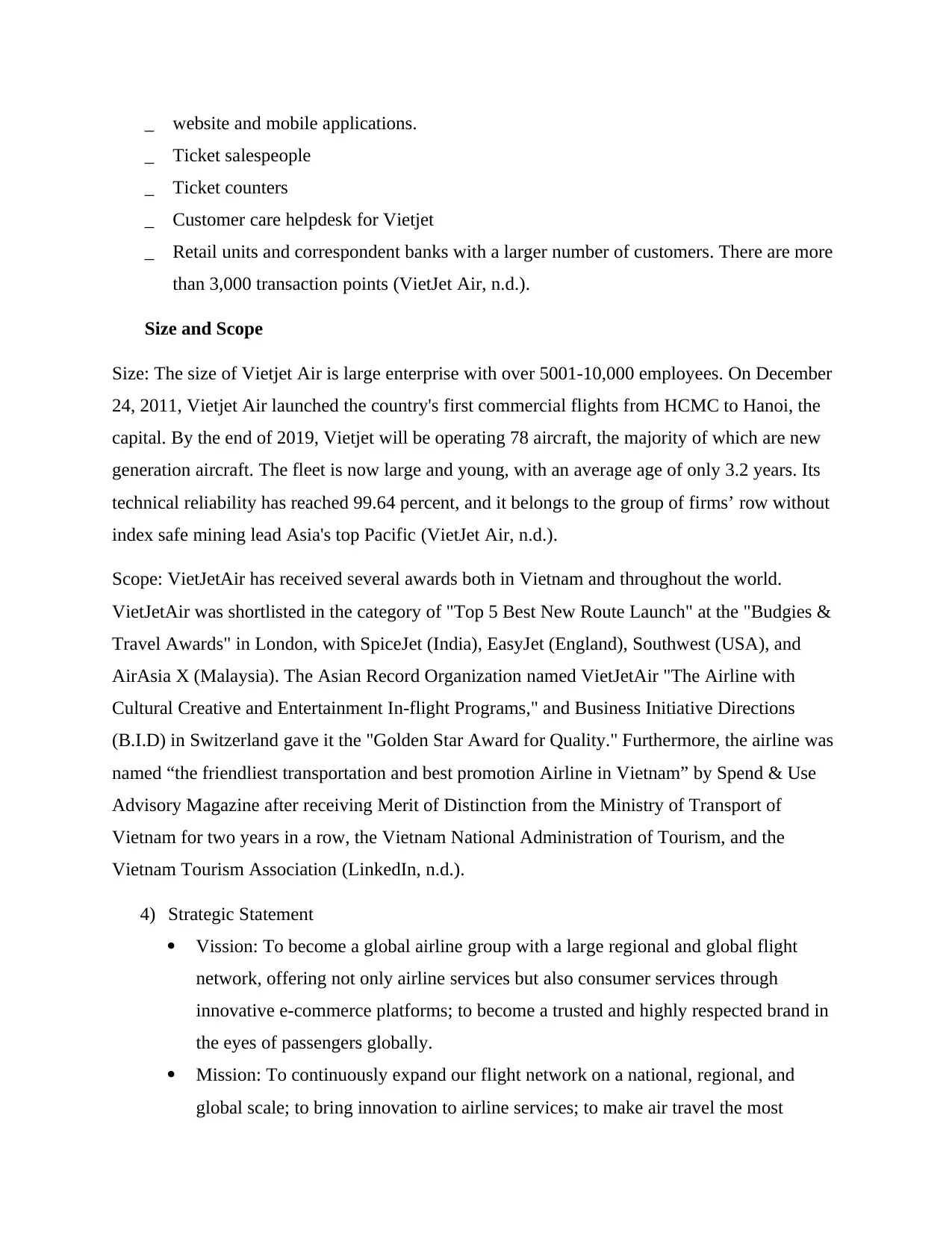
website and mobile applications.
Ticket salespeople
Ticket counters
Customer care helpdesk for Vietjet
Retail units and correspondent banks with a larger number of customers. There are more
than 3,000 transaction points (VietJet Air, n.d.).
Size and Scope
Size: The size of Vietjet Air is large enterprise with over 5001-10,000 employees. On December
24, 2011, Vietjet Air launched the country's first commercial flights from HCMC to Hanoi, the
capital. By the end of 2019, Vietjet will be operating 78 aircraft, the majority of which are new
generation aircraft. The fleet is now large and young, with an average age of only 3.2 years. Its
technical reliability has reached 99.64 percent, and it belongs to the group of firms’ row without
index safe mining lead Asia's top Pacific (VietJet Air, n.d.).
Scope: VietJetAir has received several awards both in Vietnam and throughout the world.
VietJetAir was shortlisted in the category of "Top 5 Best New Route Launch" at the "Budgies &
Travel Awards" in London, with SpiceJet (India), EasyJet (England), Southwest (USA), and
AirAsia X (Malaysia). The Asian Record Organization named VietJetAir "The Airline with
Cultural Creative and Entertainment In-flight Programs," and Business Initiative Directions
(B.I.D) in Switzerland gave it the "Golden Star Award for Quality." Furthermore, the airline was
named “the friendliest transportation and best promotion Airline in Vietnam” by Spend & Use
Advisory Magazine after receiving Merit of Distinction from the Ministry of Transport of
Vietnam for two years in a row, the Vietnam National Administration of Tourism, and the
Vietnam Tourism Association (LinkedIn, n.d.).
4) Strategic Statement
Vission: To become a global airline group with a large regional and global flight
network, offering not only airline services but also consumer services through
innovative e-commerce platforms; to become a trusted and highly respected brand in
the eyes of passengers globally.
Mission: To continuously expand our flight network on a national, regional, and
global scale; to bring innovation to airline services; to make air travel the most
Ticket salespeople
Ticket counters
Customer care helpdesk for Vietjet
Retail units and correspondent banks with a larger number of customers. There are more
than 3,000 transaction points (VietJet Air, n.d.).
Size and Scope
Size: The size of Vietjet Air is large enterprise with over 5001-10,000 employees. On December
24, 2011, Vietjet Air launched the country's first commercial flights from HCMC to Hanoi, the
capital. By the end of 2019, Vietjet will be operating 78 aircraft, the majority of which are new
generation aircraft. The fleet is now large and young, with an average age of only 3.2 years. Its
technical reliability has reached 99.64 percent, and it belongs to the group of firms’ row without
index safe mining lead Asia's top Pacific (VietJet Air, n.d.).
Scope: VietJetAir has received several awards both in Vietnam and throughout the world.
VietJetAir was shortlisted in the category of "Top 5 Best New Route Launch" at the "Budgies &
Travel Awards" in London, with SpiceJet (India), EasyJet (England), Southwest (USA), and
AirAsia X (Malaysia). The Asian Record Organization named VietJetAir "The Airline with
Cultural Creative and Entertainment In-flight Programs," and Business Initiative Directions
(B.I.D) in Switzerland gave it the "Golden Star Award for Quality." Furthermore, the airline was
named “the friendliest transportation and best promotion Airline in Vietnam” by Spend & Use
Advisory Magazine after receiving Merit of Distinction from the Ministry of Transport of
Vietnam for two years in a row, the Vietnam National Administration of Tourism, and the
Vietnam Tourism Association (LinkedIn, n.d.).
4) Strategic Statement
Vission: To become a global airline group with a large regional and global flight
network, offering not only airline services but also consumer services through
innovative e-commerce platforms; to become a trusted and highly respected brand in
the eyes of passengers globally.
Mission: To continuously expand our flight network on a national, regional, and
global scale; to bring innovation to airline services; to make air travel the most
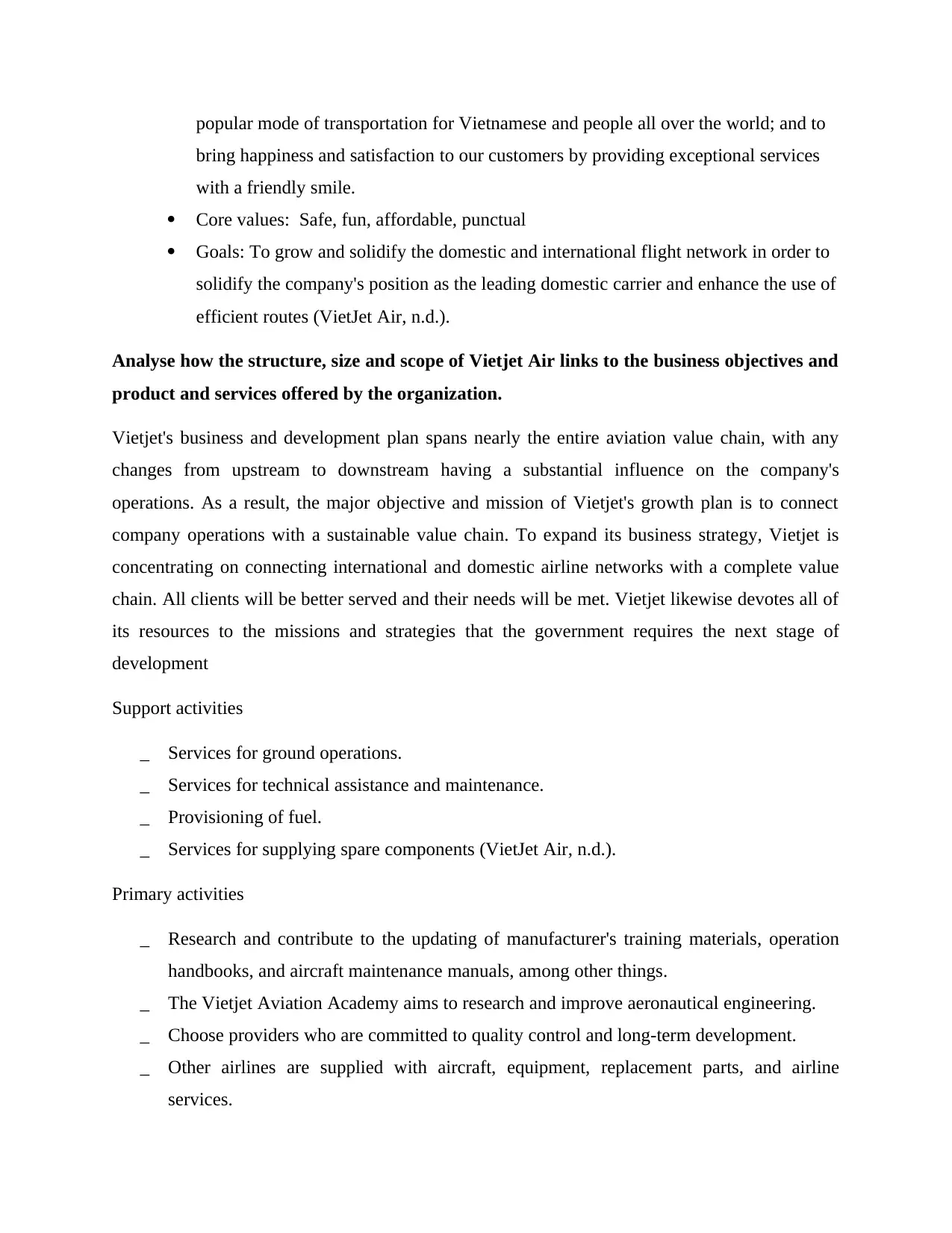
popular mode of transportation for Vietnamese and people all over the world; and to
bring happiness and satisfaction to our customers by providing exceptional services
with a friendly smile.
Core values: Safe, fun, affordable, punctual
Goals: To grow and solidify the domestic and international flight network in order to
solidify the company's position as the leading domestic carrier and enhance the use of
efficient routes (VietJet Air, n.d.).
Analyse how the structure, size and scope of Vietjet Air links to the business objectives and
product and services offered by the organization.
Vietjet's business and development plan spans nearly the entire aviation value chain, with any
changes from upstream to downstream having a substantial influence on the company's
operations. As a result, the major objective and mission of Vietjet's growth plan is to connect
company operations with a sustainable value chain. To expand its business strategy, Vietjet is
concentrating on connecting international and domestic airline networks with a complete value
chain. All clients will be better served and their needs will be met. Vietjet likewise devotes all of
its resources to the missions and strategies that the government requires the next stage of
development
Support activities
Services for ground operations.
Services for technical assistance and maintenance.
Provisioning of fuel.
Services for supplying spare components (VietJet Air, n.d.).
Primary activities
Research and contribute to the updating of manufacturer's training materials, operation
handbooks, and aircraft maintenance manuals, among other things.
The Vietjet Aviation Academy aims to research and improve aeronautical engineering.
Choose providers who are committed to quality control and long-term development.
Other airlines are supplied with aircraft, equipment, replacement parts, and airline
services.
bring happiness and satisfaction to our customers by providing exceptional services
with a friendly smile.
Core values: Safe, fun, affordable, punctual
Goals: To grow and solidify the domestic and international flight network in order to
solidify the company's position as the leading domestic carrier and enhance the use of
efficient routes (VietJet Air, n.d.).
Analyse how the structure, size and scope of Vietjet Air links to the business objectives and
product and services offered by the organization.
Vietjet's business and development plan spans nearly the entire aviation value chain, with any
changes from upstream to downstream having a substantial influence on the company's
operations. As a result, the major objective and mission of Vietjet's growth plan is to connect
company operations with a sustainable value chain. To expand its business strategy, Vietjet is
concentrating on connecting international and domestic airline networks with a complete value
chain. All clients will be better served and their needs will be met. Vietjet likewise devotes all of
its resources to the missions and strategies that the government requires the next stage of
development
Support activities
Services for ground operations.
Services for technical assistance and maintenance.
Provisioning of fuel.
Services for supplying spare components (VietJet Air, n.d.).
Primary activities
Research and contribute to the updating of manufacturer's training materials, operation
handbooks, and aircraft maintenance manuals, among other things.
The Vietjet Aviation Academy aims to research and improve aeronautical engineering.
Choose providers who are committed to quality control and long-term development.
Other airlines are supplied with aircraft, equipment, replacement parts, and airline
services.
⊘ This is a preview!⊘
Do you want full access?
Subscribe today to unlock all pages.

Trusted by 1+ million students worldwide
1 out of 30
Related Documents
Your All-in-One AI-Powered Toolkit for Academic Success.
+13062052269
info@desklib.com
Available 24*7 on WhatsApp / Email
![[object Object]](/_next/static/media/star-bottom.7253800d.svg)
Unlock your academic potential
Copyright © 2020–2025 A2Z Services. All Rights Reserved. Developed and managed by ZUCOL.




